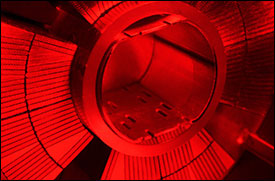
LHC Repairs to Take Months
GENEVA, Sept. 22, 2008 -- A faulty electrical connection between two magnets was most likely the cause of a magnet quench Friday that resulted in a large helium leak at the Large Hadron Collider (LHC), the world's largest particle accelerator, and will mean the collider will be shut down for at least two months, officials said. The decision means it's unlikely the atom smasher will generate collisions in 2008.
Sources at CERN, the organization hosting the collider, said the final LHC sector, sector 34, was being commissioned without the beam at high current for operation at 5 TeV when the quench occurred, leaking what was reported to be 1 ton of helium into the tunnel (See Quench Latest LHC Setback).
"CERN's strict safety regulations ensured that at no time was there any risk to people," the organization said in a press release Saturday. Preliminary investigations are pointing toward a faulty electrical connection, officials said, which probably melted at the high current, leading to the quench.
The LHC contains hundreds of magnets that need to be cooled to cryogenic temperatures (about 1 degree above absolute zero) with liquid helium in order to become superconducting and to keep the protons on course. During a magnet quench, the temperature of the magnet section becomes too high for it to be superconducting, resulting in a higher resistance that rapidly heats the current running through the magnet. That leads to even less superconductivity and more heat, which could damage the very thin wires that comprise the LHC electromagnets. The heat generated can also turn the liquid helium back into a gas, which can escape if the magnet begins to leak.
The sector will have to be warmed for repairs to take place, officials said, a process that takes weeks to achieve in superconducting magnets and will mean the collider will be shut down for a minimum of two months.

One of the Large Hadron Collider's superconducting quadrupole magnets. (Image: Copyright ©CERN)
"The bottom line is that the needed repair is not a huge one, but it will be very time consuming because of the necessity of warming up the magnets to do it. Why do we need to warm the magnets up? Well, because they're filled with liquid helium, and you can't do much work on the magnets while the helium inside," wrote Seth Zenz, a University of California graduate student working at CERN with the Lawrence Berkeley National Laboratory group on the LHC's ATLAS experiment, in a blog on the US LHC Web site today.
Zenz pointed out that, while the magnets did warm up by 100 degrees quickly during the malfunction, they did it by venting the helium into the tunnel. "...although helium isn't dangerous unless there's so much of it that it crowds out the air, it sure is expensive. The accelerator experts need to slowly warm up, remove, and store the helium; this will save it for future use and prevent damage to the magnets," he wrote.
It is unlikely the particle accelerator will generate collisions this year because it was scheduled to be shut down during the coldest winter months, when electricity is very expensive due to its use as a home heating source, Zenz wrote. Although CERN officials have not yet decided what will happen, Zenz wrote that he now expects that work planned for the shutdown will be done in conjunction with the repairs.
"Perhaps that means that the LHC will come online at full energy even a bit sooner than it would have otherwise, but bear in mind that that's speculation based more on my hopes and guesses than on my (non-existent) accelerator-commissioning expertise," he wrote.
For more information, visit: www.cern.ch or www.uslhc.us/
Published: September 2008